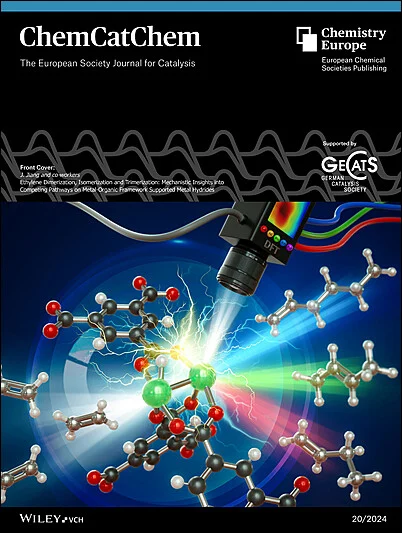Coupling of the catalytic reactions from formate dehydrogenase and hydrogenase in solution: Insights from computations and in situ IR spectroscopy
IF 3.8
3区 化学
Q2 CHEMISTRY, PHYSICAL
引用次数: 0
Abstract
Sophisticated enzymatic systems have evolved in nature to efficiently couple distinct biochemical reactions in form of cascades. As such they serve as reference models to understand the indirect interactions of catalytic centers. Herein, we studied, in solution, the coupling of the reactions from membrane‐bound [NiFe] hydrogenase (MBH) from Cupriavidus necator (reversible H2 splitting into H+ and e‐) and the molybdenum‐dependent formate dehydrogenase from Rhodobacter capsulatus (reversible formate to CO2 interconversion). To follow their interplay via the characteristic absorptions from the MBH's active site or the respective substrate and product bands of FDH, we utilized in situ IR spectrocopy and GC(‐MS), in the absence or presence of soluble redox mediators. Coarse grained molecular dynamics (cgMD) computations revealed the lack of productive enzyme complexes for direct electron transfer (ET). Thus, the observed minor amounts of H2 or formate were produced from transient interactions between the two enzymes. On the contrary, the significantly increased product formation in the presence of methylene viologen can be related to the putative multiple interaction sites of the redox mediator with FDH identified by cgMD. Our study represents a proof‐of‐concept approach that can be used in future to develop novel coupled biocatalytic systems by identifying potential ET pathways.溶液中甲酸脱氢酶和氢化酶催化反应的耦合:计算和原位红外光谱的启示
复杂的酶系统在自然界中不断进化,以级联的形式将不同的生化反应有效地结合在一起。因此,它们是了解催化中心间接相互作用的参考模型。在此,我们在溶液中研究了膜结合型[镍铁合金]氢化酶(MBH)(可逆地将 H2 分离为 H+ 和 e-)和荚膜罗杆菌的钼依赖型甲酸脱氢酶(可逆地将甲酸转化为 CO2)的耦合反应。为了通过 MBH 活性位点或 FDH 底物和产物带的特征吸收来跟踪它们之间的相互作用,我们在没有或有可溶性氧化还原介质的情况下利用了原位红外光谱和气相色谱-质谱(GC-MS)。粗粒度分子动力学(cgMD)计算显示,缺乏直接电子传递(ET)的高产酶复合物。因此,观察到的少量 H2 或甲酸盐是由两种酶之间的瞬时相互作用产生的。相反,在亚甲基紫精存在的情况下,产物形成量明显增加,这可能与 cgMD 发现的氧化还原介质与 FDH 的多个相互作用位点有关。我们的研究代表了一种概念验证方法,今后可通过确定潜在的 ET 途径来开发新型耦合生物催化系统。
本文章由计算机程序翻译,如有差异,请以英文原文为准。
求助全文
约1分钟内获得全文
求助全文
来源期刊

ChemCatChem
化学-物理化学
CiteScore
8.10
自引率
4.40%
发文量
511
审稿时长
1.3 months
期刊介绍:
With an impact factor of 4.495 (2018), ChemCatChem is one of the premier journals in the field of catalysis. The journal provides primary research papers and critical secondary information on heterogeneous, homogeneous and bio- and nanocatalysis. The journal is well placed to strengthen cross-communication within between these communities. Its authors and readers come from academia, the chemical industry, and government laboratories across the world. It is published on behalf of Chemistry Europe, an association of 16 European chemical societies, and is supported by the German Catalysis Society.
 求助内容:
求助内容: 应助结果提醒方式:
应助结果提醒方式:


